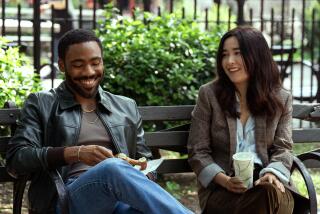MOVIE REVIEW : ‘Mr. & Mrs. Bridge’ Lacks Spark Despite the Polish of Its Stars
- Share via
Like “A Room With a View” and “The Europeans” and “The Bostonians,” the new Merchant-Ivory film “Mr. & Mrs. Bridge” has a crisp, literate veneer. It exhibits the high-toned, Masterpiece Theatre-style refinement that many people equate with “quality” moviemaking, and which some of us find a little dull.
Set in the ‘30s and ‘40s, “Mr. & Mrs. Bridge” (Park Theatre) isn’t dull exactly. Its stars, Paul Newman and Joanne Woodward, are on screen virtually all of the time, and they’re always worth watching. But the film puts such a premium on tastefulness that it never threatens to become exciting. The marriage of Walter Bridge, a successful Kansas City attorney, and his wife India, mother of three, is held up as a kind of forlorn, nostalgic paradigm for a way of life that’s all but vanished.
Director James Ivory, working from a script by Ruth Prawer Jhabvala, doesn’t give the material the faintly satiric spin that was present in the two Evan S. Connell novels upon which it’s based--”Mrs. Bridge” (1959) and “Mr. Bridge” (1969). Instead, the filmmakers have fashioned a grudging tribute to WASP country-club mores. It’s a Bush-era “Father Knows Best.”
Except for a few scenes together in the 1984 “Harry and Son,” this is the first time Newman and Woodward have worked together since “The Drowning Pool,” 15 years ago. At their best, they have the kind of lived-in rapport that can’t be faked. It’s not a matter of trading on their own marriage; they’re actors here, not celebrities--they use their real-life intimacy to create a marriage that is totally in character.
Married performers, even the most proficient of them, like Hume Cronyn and Jessica Tandy, often can’t resist winking at the audience. But Newman and Woodward are impeccably self-contained; they don’t turn “Mr. and Mrs. Bridge” into a “vehicle” for themselves.
The best reason to see the film is for the emotional shadings Woodward gives to the prim, needy Mrs. Bridge. In a later generation India’s spiritedness might have been her salvation, but, in her own time, she’s so totally imprisoned inside her husband’s rectitude that she can’t even think for herself. Particularly after her children have grown up and moved out, she fills her days with painting lessons and card parties; she moves half-dazed through her own jeweled orbit.
But Woodward also shows us how India, without ever being able to articulate her unhappiness, is unfulfilled by her life. She gets at the terror underneath India’s uncomprehending obeisance. This woman has everything in life that women in her era were supposed to live for, and yet it’s not quite right. Her idealized home-and-hearth fantasy doesn’t match up with reality. The most tender scene between India and her husband occurs, appropriately enough, in a bank vault, as Walter, concerned about his mortality, reviews with her the contents of their safe deposit box.
If Mr. Bridge had been fashioned by the filmmakers with the same delicacy as India, the movie might have been a low-key stunner. But, despite Newman’s uncompromising performance, the movie doesn’t really undercut Walter’s sensibilities. Part of the reason for this is a deliberate softening of Connell’s conception: for example, Walter’s antagonisms towards blacks and Jews has been toned way down.
But it’s also because Ivory’s aesthetic sensibility is on the same wavelength as Walter’s. The decorous, moneyed world of the Bridges, with its patterned lawns and gardens and its porcelain and its Old Master reproductions, strikes as resonant a chord in the filmmaker as India’s misery--perhaps more so. The film itself is an overplanned piece of picture-book patterning, with each of its sections keyed to the seasons.
Newman, coming off his raucous, career-stretching performance in “Blaze,” may have felt the need to retreat deeply into Walter’s dour recesses. The role feeds into a stolid reticence that Newman sometimes cultivates, and it doesn’t have enough levels. And when the filmmakers do try for a few more levels, they retreat in horror. There’s a baffling scene, for example, where Walter views his teen-age daughter Ruth (Kyra Sedgwick) sunbathing, and is so turned on that he immediately lunges for his wife. This incestuous material is also present in Connell’s “Mr. Bridge,” but it made sense there as an acknowledgement of Walter’s murky depths. In the movie, where Walter is otherwise murk-less, the scene is just a grotesque aberration. It’s as if Ivory planned to take the character in a whole other direction, changed his mind, and then forgot to edit out the offending passage.
“Mr. & Mrs. Bridge” (rated PG-13) may have been intended as a rueful elegy: a drama about the tragedy of success. But the filmmakers covet Mr. Bridge’s successes too closely; they don’t provide enough distance, and so he comes across as a kind of hero by the end. Virtually all of his dire predictions about the fate of his errant children come true--Father Knows Best.
There are bound to be people who put down the film’s failings to its milieu, as if any film about Republican country-clubbers was doomed to shallowness. But the shallowness is with the filmmakers, not the milieu. If you doubt it, look again at Woodward’s performance and imagine what the film might have been like if her sensitivity had inflamed the entire production.
More to Read
Only good movies
Get the Indie Focus newsletter, Mark Olsen's weekly guide to the world of cinema.
You may occasionally receive promotional content from the Los Angeles Times.










